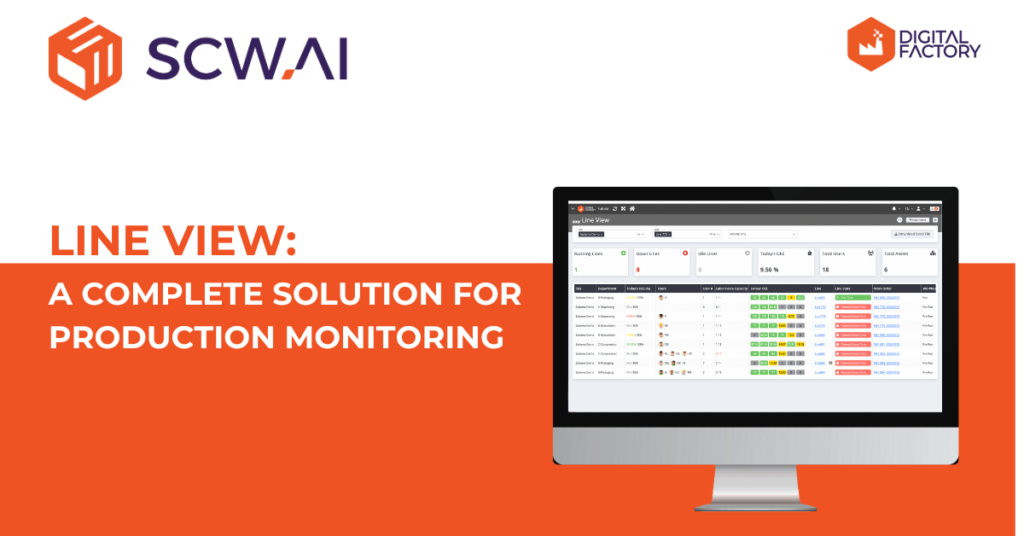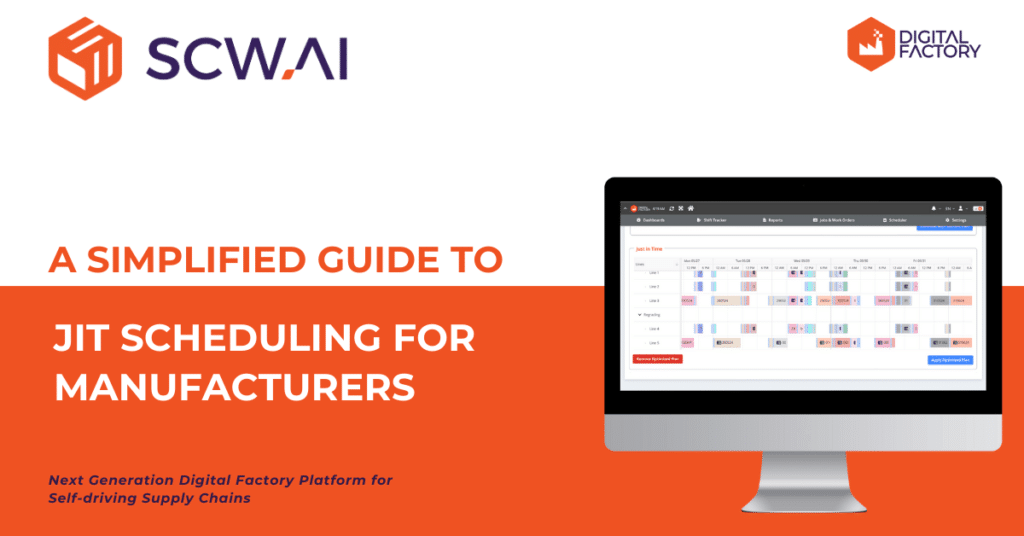In manufacturing processes, the time between two run times, often referred to as the changeover period, is when lines and machines are cleaned and set up in preparation for the next work order. Although this cleanup and setup time is essential for manufacturers, it is non-productive and can consume a significant amount of time, especially in heavily regulated industries. For instance, according to our OEE analysis of the pharmaceutical industry, an average producer dedicates around 30% of staff time to changeover activities. This unproductive time must be minimized for higher profitability.
In this article, we will highlight how scheduling work orders in different ways is the main determinant of changeover time. First, we will introduce changeover minimization as an optimization scenario for the job shop scheduling problem. Then, to demonstrate the importance of changeover minimization through effective scheduling, we will present a simple scheduling problem. Next, we will discuss the role of AI schedulers in solving changeover minimization problems and identify which industries can derive the most benefit from such tools. Finally, we will introduce our AI scheduler, which can minimize changeover time as well as optimize other scheduling scenarios such as just in time production and OTIF maximization.

How Changeover Minimization with Scheduling Works?
Changeover minimization with scheduling aims to reduce planned downtime due to cleaning and setup processes by strategically sequencing production jobs.
A key strategy is to prioritize scheduling jobs from the same product family whenever possible. This is because products within a family often share similar characteristics, leading to minor changeovers that require minimal cleaning or adjustments. For instance, switching between producing 20mg and 40mg tablets of aspirin would likely be a minor changeover.
However, switching to a completely different product, like an antibiotic with a unique set of raw materials, would necessitate a major changeover with more extensive setup procedures.
Scheduling also always considers due dates. By prioritizing jobs with approaching deadlines alongside similar products, manufacturers can minimize changeovers while ensuring on-time delivery. In summary, changeover minimization with scheduling focuses sequencing the same product families as much as possible without causing late deliveries.
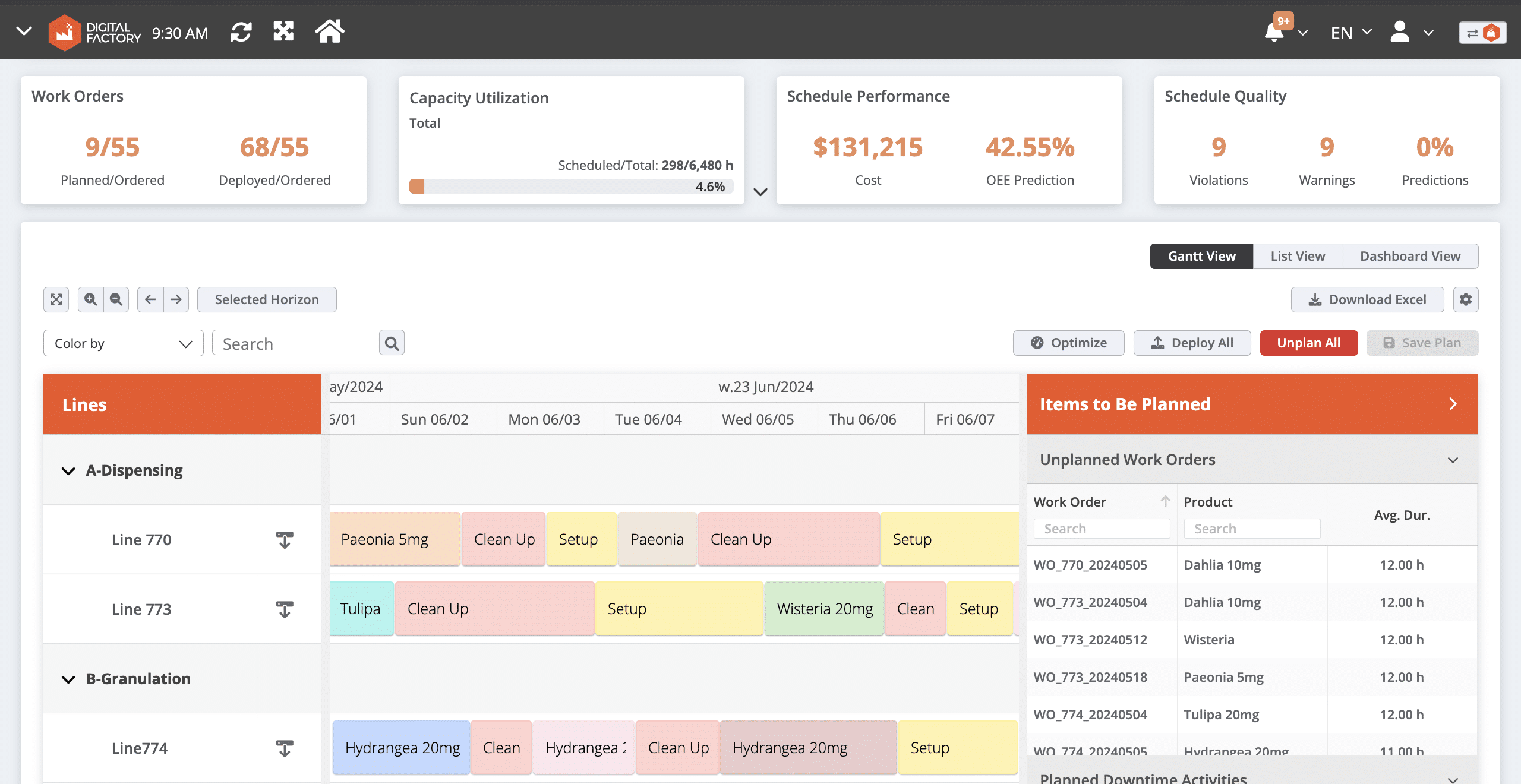
The below example might further illustrate how changeover minimization with scheduling works.
Changeover Minimization Scheduling Problem Example
This section of the article will demonstrate the impact of effective scheduling on changeover minimization using a realistic example. We will present a short job shop scheduling problem with 9 work orders across three different product families (A, B, and C), assigning realistic changeover periods between different product families and due dates. We will then solve the problem to find the optimal scenario by considering the due dates of the work orders to ensure timely delivery. Finally, we will highlight the potential losses caused by unplanned downtime in a non-optimal solution.
Let’s consider a job shop with the following work orders with given due dates and product families information:
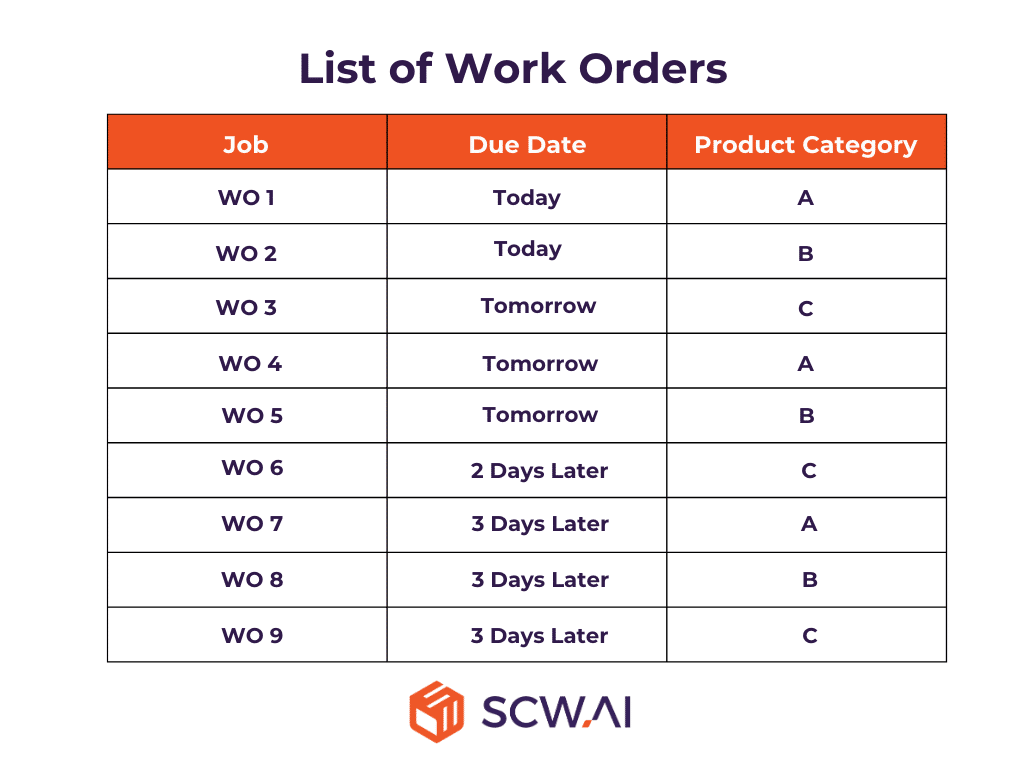
Additionally, consider the changeover periods between certain product categories, as shown in the following values.
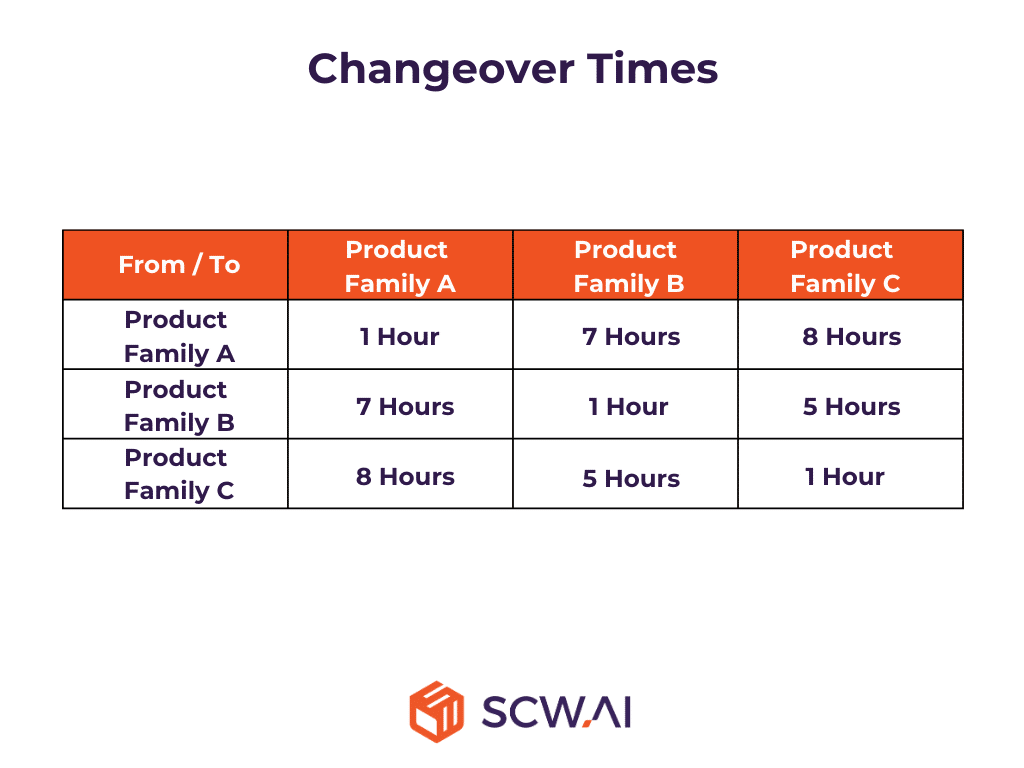
Solving the Problem
The goal is to minimize total changeover time while meeting due dates. Problem can be solved by considering following 2 steps:
- Group Products by Same Family: As indicated in the changeover time table, products within the same family have shorter changeover periods due to similar raw materials causing reduced cleaning requirements. Grouping these products together helps minimize changeover time.
- Group Work Orders by Closer Due Dates: This tactic ensures that due dates are met. For example, if you sequence all Product Family A’s consecutively followed by all Product Family B’s, you might minimize changeover periods but risk missing due dates for work order 3.
When we apply these steps to find a near optimal solution for changeover minimization we will have the following sequencing with a total changeover time of 28 hours.
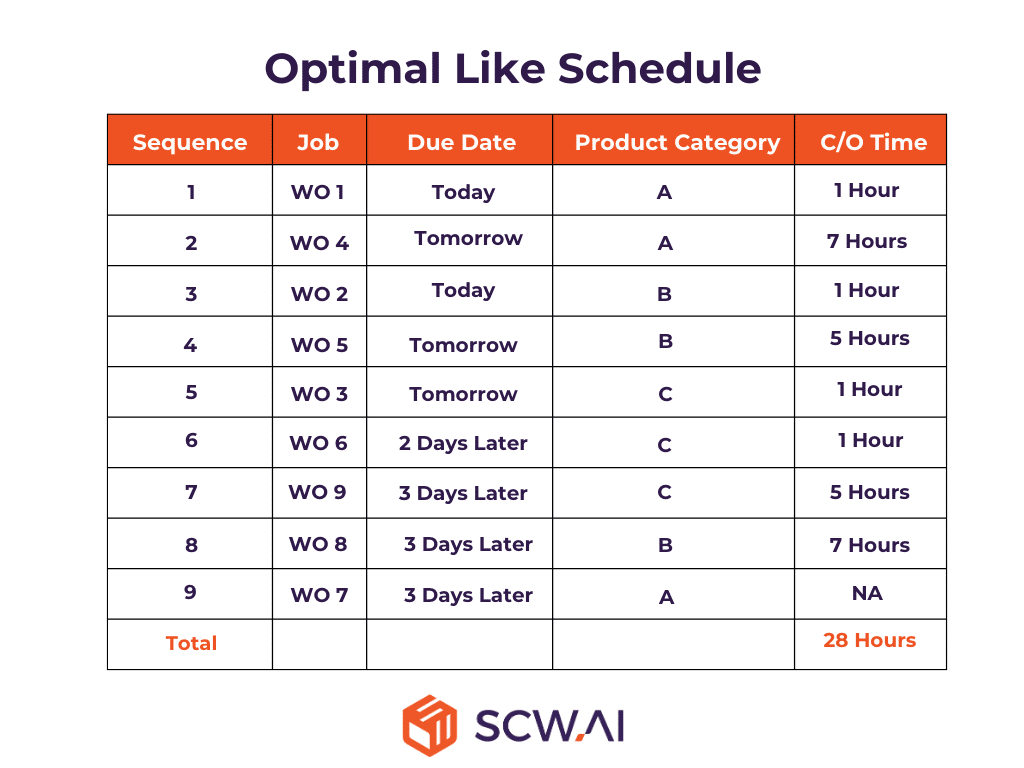
On the other hand non-optimal schedules can cause significantly higher changeover durations for even 9 work orders. For instance, if you sequence work orders 1 to 9 without considering changeover period we would have a total changeover of 52 hours.
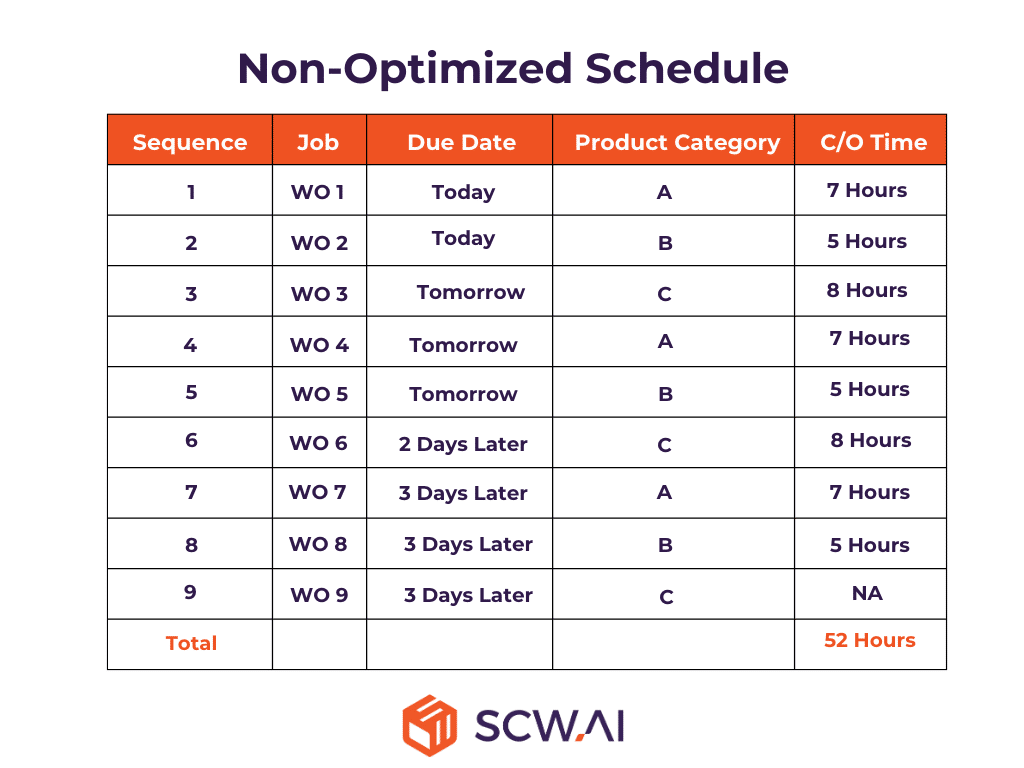
Limitations of the Example
This example is oversimplified to illustrate the basic principles of changeover minimization and effective scheduling. In a real-world manufacturing setting, the complexity increases significantly:
- Scale of Operations: Instead of 9 work orders and 3 product families, manufacturers often deal with hundreds of work orders and dozens of product families, making scheduling much more complex.
- Variability Within Product Families: We assumed all changeover periods within the same product family are the same. In reality, different configurations of machines and setups can cause variations in changeover times even within the same product family.
- Additional Constraints: This example considers due dates but does not account for On-Time In-Full (OTIF) agreements, which are critical for cost and customer satisfaction. Additionally, some products may lose freshness quickly and require just in time delivery, adding another layer of complexity to scheduling.
- Dynamic Factors: Factors such as machine breakdowns, varying operator skills, and unexpected order changes can further complicate the scheduling process.
AI Scheduler’s Role in Changeover Minimization
Even in our simplified example with a small number of work orders and product families, finding the best possible schedule was quite challenging. In real-world factories, changeover minimization problems are often much more complex. This is where AI models show their true value. Their powerful computing abilities allow them to solve these complex scheduling problems very quickly. For instance, a study by the Boston Consulting Group (BCG) found that AI models can cut the time it takes to create a schedule in half.
The benefits of AI go beyond speed. These models can also create better schedules than humans can in many cases. The same BCG study showed that AI-powered scheduling for changeover reduction can increase daily production time for manufacturers by around 30 minutes. We have seen similar results in our own experience. Many manufacturers believe their current scheduling is already perfect, but when they try our AI Scheduler, they often see significant improvements, whether they are trying to minimize changeovers, reduce costs, or deliver products on time and in full.
Another advantage of AI in minimizing changeover times is the creation of digital twins of factories. By analyzing historical processes, these tools can refine your master data. For example, a manufacturer might plan a changeover to take 1 hour. However, if recent batches of the same kind of changeover took 2 hours, the digital twin can adjust your scheduling to reflect this reality. This improves schedule adherence, allowing you to provide customers with more realistic due dates and calculate your own costs more precisely.
Do you know generative AI technology can be your starting point for building a digital twin of your factory? To learn more you can read our In-Depth Guide to Generative AI in Manufacturing article.
Top 3 Benefits of Changeover Time Optimization
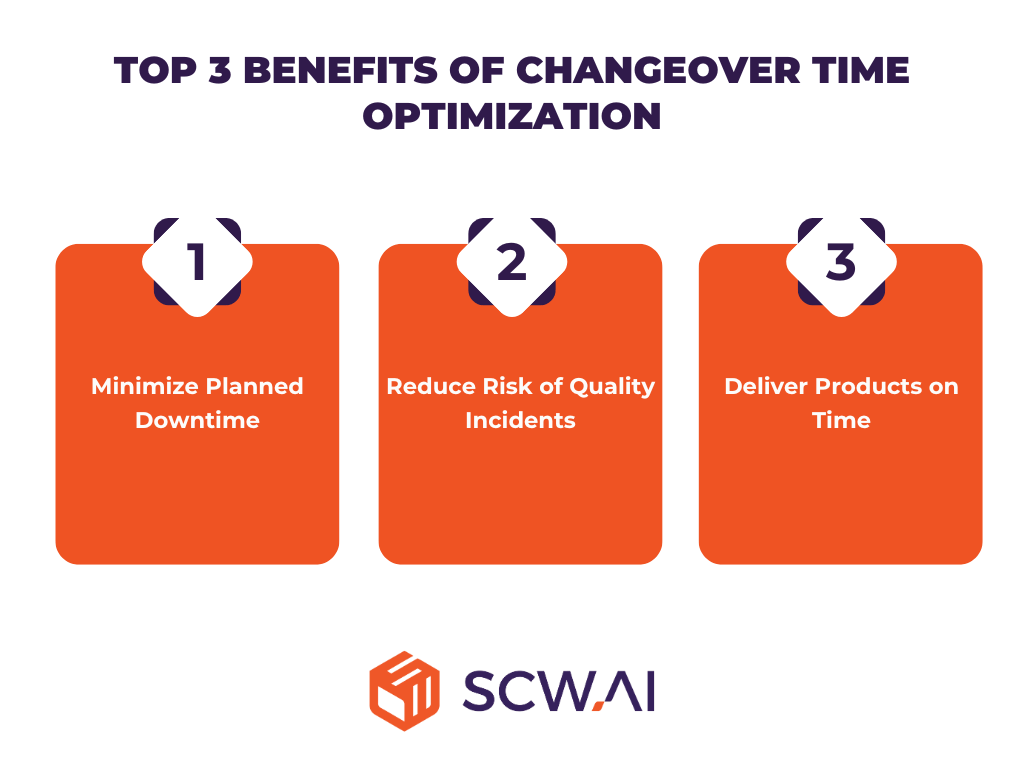
1. Minimize Planned Downtime
When manufacturers schedule products with similar raw materials, they can reduce cleaning time. Especially in regulated industries like pharmaceuticals, optimizing changeover duration alone can improve Overall Equipment Effectiveness (OEE) by around 20 percentage points.
2. Reduce Risk of Quality Incidents
Major changeovers pose the risk of production mistakes for manufacturers. Minimizing the major changeovers with different product families would reduce the risk of accidentally mixing flavors, raw materials and other externalities. Consequently, switching major changeovers with minor ones ensures purer product quality.
3. Deliver Products on Time
Changeover minimization improves the productive time of a factory. Thus, manufacturers are likely to produce more goods in a given period of time and deliver them to the customers on time.
Top 3 Industries Can Benefit From Changeover Time Minimization with AI Scheduler
1. Pharmaceutical Manufacturing
cGMP (Current Good Manufacturing Practice) regulations are paramount in pharmaceutical manufacturing. These regulations necessitate extensive cleaning procedures between production runs of different drugs to prevent cross-contamination. This translates to lengthy changeovers, impacting overall production speed and efficiency.
By optimizing schedules and minimizing changeover times, AI can significantly reduce cleaning times in pharmaceutical production. This translates to faster production cycles without compromising product quality or safety.

2. Food and Beverage
Similar to pharmaceuticals, the food and beverage industry prioritizes hygiene and safety. Lengthy changeovers between production runs of different food items can introduce contamination risks. AI scheduling with changeover minimization offers a solution. By optimizing production sequences and minimizing changeover times, AI can streamline production while maintaining operational excellence.
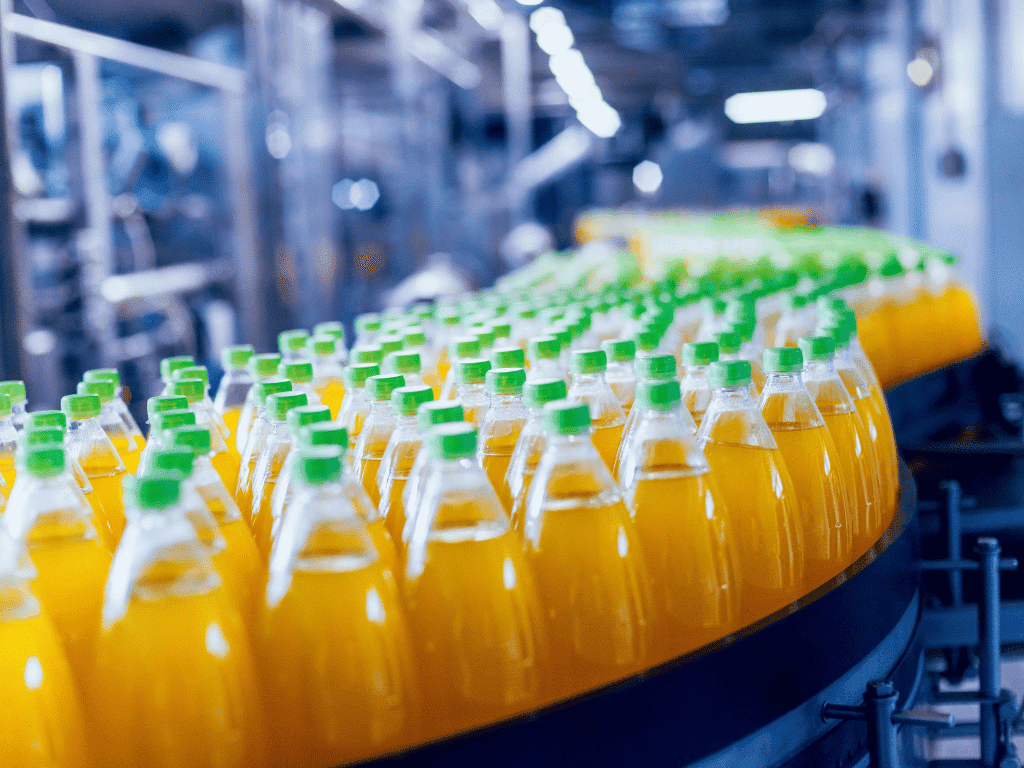
3. Textile
The textile industry, particularly yarn dyeing for fabric production, can significantly benefit from AI scheduling. When dyeing yarns in specific color sequences, minimizing changeover times between colors is crucial for maximizing profits. AI scheduling excels in this area. By intelligently sequencing dye production batches with similar colors, AI reduces cleaning times required between color changes. This translates to cost savings through:
- Reduced wasted time
- Lower water consumption
- Minimized energy usage

It is important to note that this approach is not limited to textiles. AI scheduling can be applied across various industries with similar production processes, promoting efficiency and maximizing profits.
Minimize Your Changeover Time with Our AI Scheduler
Our AI Scheduler effectively solves many scheduling problems, including changeover minimization, in just a few clicks. Beyond job shop scheduling, Scheduler offers a digital interface and reports for:

In addition, our cloud manufacturing solution, Digital Factory Platform, allows manufacturers to monitor machines, lines, and labor. This empowers managers to improve your total productive maintenance initiatives and successfully execute schedules. Additionally, you can automate factory data collection, display, and interpretation.
To learn more about our offerings, fill out a contact form and ask your questions.
Book a demo to see our Scheduler in action.
